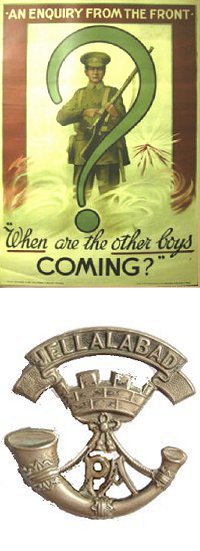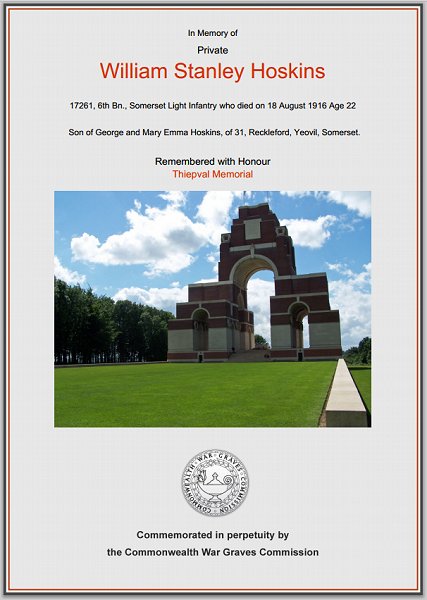yeovil at War
William Stanley Hoskins
Killed in action during the Somme Offensive
William Stanley Hoskins, known as Stanley, was born in Yeovil in 1895. He was the son of marble worker George Hoskins and Emma née Wood. In the 1901 census George and Emma were living at 76 Sherborne Road with their children; Albert, known as Bertie, (b 1894), Stanley and daughter Ruby (b 1899). George listed his occupation as 'Leather Cutter and Marble Graphite Worker'. By 1911 the family had moved to 31 Reckleford and George gave his occupation as a Marble Mason while both 19-year old Albert and 16-year old Stanley were listed as Glove Cutters and worked at Ewens & Robbins.
 Albert
enlisted in the
8th Battalion of
the Somerset
Light Infantry
at the outbreak
of war and
Stanley enlisted
in February 1915, joining
the
6th Battalion of
the Somersets.
His Service
Number was
17261.
Albert
enlisted in the
8th Battalion of
the Somerset
Light Infantry
at the outbreak
of war and
Stanley enlisted
in February 1915, joining
the
6th Battalion of
the Somersets.
His Service
Number was
17261.
Although he joined the 6th Battalion, it would appear that when he was sent to France, around May 1915, he served with the 1st Battalion.
In early 1916 Stanley was sent back to England suffering from inflamed legs and was hospitalised at Edinburgh Red Cross Hospital. He later returned to the Front.
In 1916 the 1st Battalion, to which Stanley was attached, moved south and were in action during the Battles of the Somme.
The Battle for the Somme has a unique place in British military history. Haig was in the middle of preparations for a British offensive but came under strong pressure to mount an attack due the French commitment to the Battle for Verdun, a city which held an important place in the nation's psyche and that the Germans had attacked in February 1916. Any Allied offensive would therefore have to be carried mainly by the British. Haig was therefore forced to undertake an offensive near to where the British and French lines met, near Bray-sur-Somme in Picardy, although he would have preferred to attack further north and to have had longer with which to prepare his new army. The battlefield was bisected by both the Albert – Bapaume Road and the River Somme, and was a series of gentle chalk ridge lines into which the Germans had dug a series of well-prepared fortifications. Haig's plan called for Rawlinson’s Fourth Army to achieve a breakthrough in the centre after which Gough’s Reserve Army (later renamed the Fifth Army) would exploit, roll up the German defences and capture Bapaume. Allenby's Third Army would undertake a diversionary attack on Gommecourt, which lay to the north. The massive preparatory bombardment, meant to destroy the German defences started on 24 June 1916 at 06.00. Over 1.7 million shells were fired but a high proportion, some 30 percent, failed to explode as the Ministry of Munitions had abandoned any semblance of quality control in order to be able to produce the quantities needed in time. Tunnelling companies dug hollowed out chambers underneath key German strongpoints and filled them with explosives. The shelling had started on 'U' Day and was meant to go on until 'Z' Day, which was 29 June 1916 but heavy rains caused the approach roads, trenches and crater ridden No-Man's land too muddy and so the assault was postponed until 1 July. Just after dawn on 1 July, the first British wave clambered out of their trenches and started to make their way towards the German frontline. As they did, seventeen enormous mines were detonated and the barrage moved forward. The infantry followed behind and although there were local gains on the first day, generally things looked bleak. The British suffered 57,470 casualties (19,240 killed and 2,152 missing) which was an unprecedented experience for the British Army. Seven 'New Army' divisions attacked, alongside three Territorial and four regular Army divisions. The French attack on the right of the British line was smaller than had been originally intended as troops had to be diverted to the fighting around Verdun but their attack went relatively successfully and the preponderance of heavy guns in the French sector also helped the British forces adjacent to them. The British Army suffered, over the course of the entire 142-day campaign, some 415,000 casualties. The Somme campaign involved some twelve separate battles and finally came to an end on 18 November 1916.
On 8 August 1916 Stanley was reported missing in action and is presumed to have died on that day. He was just 22 years old.
On 25 February 1916, the Western Gazette reported "Mr and Mrs G Hoskins, of 31 Reckleford, have been officially notified that their son, Private Albert Hoskins, was wounded on New Year’s Day whilst in action with the 8th Battalion, Somersets. His parents have since received letters from him from a Red Cross Hospital in Manchester, where he is said to be making favourable progress towards recovery, having been wounded in the chest. Private Hoskins, a glove cutter by trade, joined the Army at the beginning of the war and had been serving at the Front about five months. Intelligence has also been received that Mr and Mrs Hoskins other son, Stanley who had been serving nine months at the Front as a private in the 1st Battalion, Somerset LI, has been invalided to an Edinburgh Red Cross Hospital, suffering from inflammation of both legs. Private Hoskins gave up employment as a glove cutter in the town to enlist about twelve months ago, and was drafted to the Front on the completion of three months training."
On 22 June 1917, the Western Gazette reported "Mr and Mrs G Hoskins, of 31 Reckleford, have received notification from the War Office intimating that no further news has been received of their son, Private Stanley Hoskins (Somerset LI), who has been missing since August 18th last year, and the Army Council were regretfully constrained to conclude that he is dead and that his death occurred on or about that date. Prior to joining the Army in February 1915, the deceased was a glove cutter in the employ of Messrs. Ewens & Robbins. He went to France after three months training, and at the time of his death was only 22 years of age."
William Stanley Hoskins is commemorated on the Pier and Face 2A of the Thiepval Memorial, Somme, France, and his name is recorded on the War Memorial in the Borough.
gallery

The Commonwealth War Graves Commission certificate in memory of Stanley Hoskins.